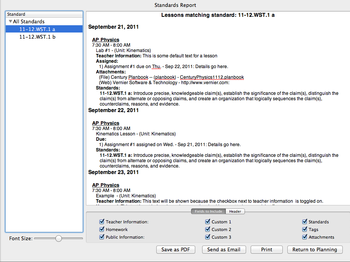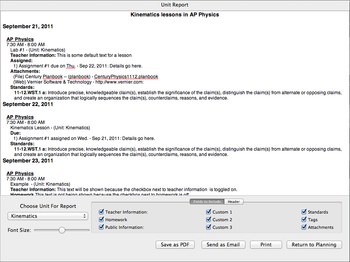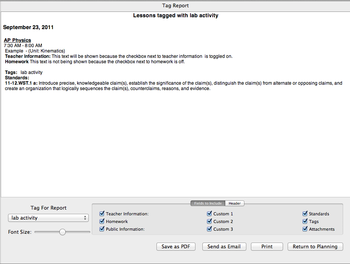Special Reports
Contents |
Overview
In addition to the weekly report and daily report, Planbook offers three other reports to help your print, email or save your plans. These three reports are:
- Standards Report
- Unit Report
- Tag Report
This document will first discuss the specifics of the three reports and then the common mechanisms for customizing the reports.
Standards Report
The Standards Report is designed to show you all the lessons, in chronological order, that address a particular standard.
The Standards Report features an outline view showing all of the standards that you have added your plans. You can click on any of the standards to update the generated report to show only the lessons focusing on that particular standard. The image to the right shows the lessons focusing on the 11-12.WST.1 a standard.
The Standards Report does not look to the left side sidebar to determine which courses to display in the generated report. The Report will show all the lessons with the selected standard, regardless of the lesson's course and subject.
In the case of nested standards, the Standards Report will show all the lessons with any of the sub-standards applied.
See below for information about modifying the special reports, sharing the special reports, copying the special reports, and returning to Planning mode.
Unit Report
The Unit Report is designed to show all of the lessons that have been added to a particular unit.
The Unit Report features a pop up menu showing all of the units that you've added to your planner. Selecting any of the units will result in the report automatically regenerating, showing that unit's lessons in chronological order.
The Units Report does not look to the left side sidebar to determine which courses to display in the generated report. The Report will show all the lessons within the selected unit, regardless of the lesson's course and subject.
See below for information about modifying the special reports, sharing the special reports, copying the special reports, and returning to Planning mode.
Tag Report
The Tag Report is designed to show all of the lessons that have been tagged with a particular keyword.
The Tag Report features a pop up menu showing all of the keywords that you've used to tag lessons in your planner. Selecting any of the keywords will result in the report automatically regenerating, showing that keywords lessons in chronological order.
The Units Report does not look to the left side sidebar to determine which courses to display in the generated report. The Report will show all the lessons tagged with the keyword regardless of the lesson's course and subject.
See below for information about modifying the special reports, sharing the special reports, copying the special reports, and returning to Planning mode.
Modifying the Special Reports
Changing the Fields Displayed
In the lower section of any of the special reports, you'll see a set of checkboxes that control the fields that are displayed when generating the report.You can choose to show any (or all) of the six text entry fields. If a field is selected to be shown, but a lesson does not have information entered into that field, the field will not be shown. You can also choose to show the Standards applied to a lesson, the keywords that a lesson has been tagged with, and the file/web link attachments.
Always Visible Fields
The lesson title and assignments are always visible in the special reports.
Modifying the Report Format
There is a single option for modifying the format of the Special Reports. You can increase or decrease the font size of the report using the Font-Size slider.All of the special reports features a number of different font sizes for the different components of the report. The font size slider will adjust all the font sizes proportionally.
Adding a Header
You can also add a customized header to any of the special report using the header tab. You can enter any text into the header field.You can change the font or font size of the report header by bringing up the Font panel using the keyboard shortcut command-T.
Sharing the Special Reports
Planbook offers three choices for sharing your Special Report with peers, administrators or others.
- The Print button brings up the standard Mac OS print dialog and lets you print directly to any printer accessible from your computer.
- The Send as Email button generates a PDF of the currently visible report and opens a new Mail message with the PDF as an attachment. Apple's Mail application is the only supported Mail program. Only Available on Mac OS 10.6+.
- The Save as PDF button generates a PDF of the currently visible report and lets you choose a name and location for the file. This file can be attached to a non Apple Mail message, shared via USB drive or otherwise manipulated in the same manner as any other file on your computer. Only Available on Mac OS 10.6+.
Copying the Special Reports
In addition to the built in method for sharing, you can also select the text in the a Special Report and copy it into any application you choose (Apple Mail, Apple Page, MS Word, etc...). To copy the text into another application:
- Double click any word in the generated report.
- Use the keyboard shortcut command-a to select the entire text of the report.
- Use the keyboard shortcut command-c (or the Edit-->Copy menu item) to copy the text to the clipboard.
- Switch to the desired application and paste the text using command-v or the Edit-->Paste menu item.
Returning to Planning Mode
When you are done with any of the Special Reports, click the Return to Planning button to return to the editing mode you were using previously.




